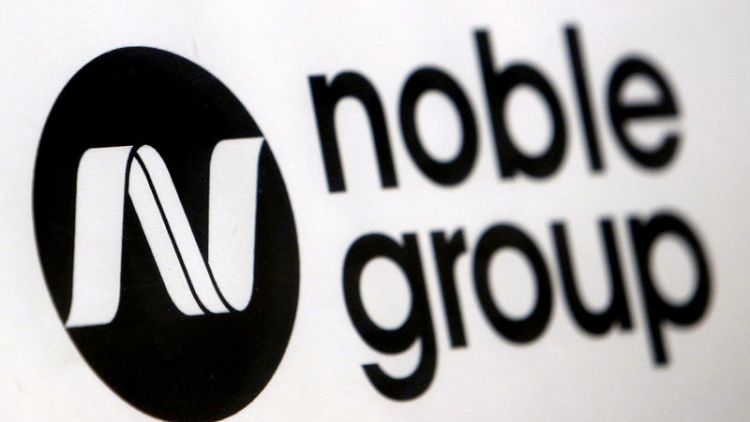By Anshuman Daga
SINGAPORE (Reuters) - In May 2017, Paul Brough had just assumed the chairmanship of Noble Group <NOBG.SI> and immediately faced a room full of angry bankers demanding their money back from the struggling commodity trader.
Mustering all his 25-plus years of experience as a restructuring specialist, Brough needed their support to keep the credit lines open that underpinned the operations of what had once been Asia's biggest commodity trading house.
At the meeting in Amsterdam in late May, banks were shocked by a recently reported quarterly loss and were in no mood to keep supporting the company.
"The atmosphere in the room was highly charged," Brough told Reuters in an interview last week. "A number of them were already taking the decision that they wanted to exit the relationship," said Brough, a former senior regional partner at KPMG in Hong Kong who helped wind up the Asian business of Lehman Brothers.
The following week's meeting with U.S. banks did not go much better, with Brough, 61, saying the banks "made it very clear that they wanted their secure debt repaid very, very quickly."
However, Brough, who managed China's Sino-Forest after its $4 billion collapse in 2011, convinced the U.S. banks to give Noble a 120-day debt reprieve to sell its assets in the United States.
From there, Brough, who took over from company founder Richard Elman, brought Noble back from among the biggest near-death corporate experiences in Asia. The company last week secured shareholder support for a $3.5 billion debt restructuring.
In the 15 months between Brough's appointment and last week's deal, Noble dramatically downsized and reported a $4.9 billion loss for 2017, including a $2.1 billion valuation adjustment of its controversial derivatives contracts.
By the time Brough became chairman, Noble had fended off two years of accusations by Iceberg Research that it had inflated its assets. Noble, which has stood by its accounts, later revealed Iceberg to be led by ex-Noble credit analyst Arnaud Vagner.
When Brough took charge, Noble had lost 80 percent, or nearly $5 billion in market value, since Iceberg issued its first report in February 2015.
Brough reckons he travelled 500,000 miles negotiating with hundreds of creditors and shareholders from Hong Kong and Singapore to New York, London and Amsterdam.Noble then hired investment bank Moelis & Company and lawyers Kirkland & Ellis, specialists in debt restructurings, the first sign of a possible wholesale restructure.
PJT Partners and Comprador Ltd joined as financial advisors as Brough unveiled a strategic review of Noble. He brought together seven of its core trade finance banks at the Amsterdam meeting.
Those banks included MUFG Bank, ING Bank and Rabobank. MUFG and ING declined to comment, while Rabobank did not respond to a Reuters query.
"It was really one of those meetings that served as a kick-off meeting where everybody was put on alert," said a person who participated in the talks.
For a related graphic, click https://tmsnrt.rs/2NaUFXq
COMPLEX RESTRUCTURING
Noble's rescue is viewed as one of the most complex debt restructurings due to its global trading business and the mix of creditors, from banks to different strata of bondholders and shareholders.
"The dual needs of keeping Noble adequately capitalised with trade finance at a time when bankers were very nervous about relationships and when customers are also very nervous, meant that it was very, very challenging," said Neil McDonald, a partner at Kirkland Ellis.
When Noble won an extension for its credit facilities in June 2017, its shares surged 50 percent, but bond prices slid after it skipped an interest payment.
"We had to call banks morning, noon and night to make sure they were comfortable with the restructuring," said one advisor. For Brough, those summer months were the lowest point in the salvage operation, with "banks making aggressive requests" and there were times Noble could have run out of cash.
"We found ourselves having to increase the margin that we were giving banks for our trade finance facilities and for our brokerage facilities," he said.
GLIMMER OF HOPE
Noble agreed to sell its U.S. gas and power business to Mercuria for $248 million last July, a deal that also increased its trade finance access. Then in October, it announced the sale of its most capital-intensive business, oil trading, to Vitol for $1.2 billion. "The first glimmer of hope was when we announced the sale of the oil business," said Brough, who will step down after the restructured company, focusing on coal and freight trading in Asia, kicks off later this year.
In November, Noble formally announced the debt restructure and then agreed to a deal to give creditors 80 percent of the new company equity. Resistance from big shareholders such as Elman, and Goldilocks Investment Co, an Abu Dhabi-based fund, put it at risk.
But in March, Noble's creditors agreed to give existing shareholders a 20 percent equity share, up from a previous 10 percent, with an ultimatum - back the proposal or face insolvency.
However, Iceberg's Vagner says the new Noble will still be debt-heavy. "Most importantly, interest skyrockets. So, it will incur almost the same interest costs," he told Reuters by email.
Noble will also gain $800 million in trade financing and hedging facilities from ING and Deutsche Bank, the last two banks supporting the company, down from 70 banks five years ago.
(Reporting by Anshuman Daga; Editing by Christian Schmollinger)



